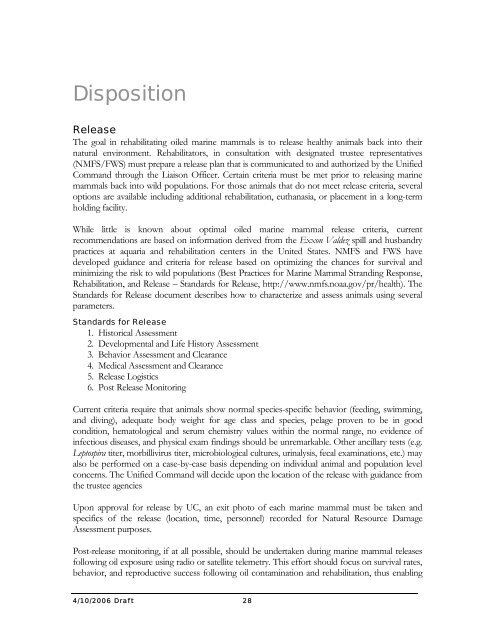Volume III, Appendices EM - National Marine Fisheries Service ...
Volume III, Appendices EM - National Marine Fisheries Service ...
Volume III, Appendices EM - National Marine Fisheries Service ...
Create successful ePaper yourself
Turn your PDF publications into a flip-book with our unique Google optimized e-Paper software.
Disposition<br />
Release<br />
The goal in rehabilitating oiled marine mammals is to release healthy animals back into their<br />
natural environment. Rehabilitators, in consultation with designated trustee representatives<br />
(NMFS/FWS) must prepare a release plan that is communicated to and authorized by the Unified<br />
Command through the Liaison Officer. Certain criteria must be met prior to releasing marine<br />
mammals back into wild populations. For those animals that do not meet release criteria, several<br />
options are available including additional rehabilitation, euthanasia, or placement in a long-term<br />
holding facility.<br />
While little is known about optimal oiled marine mammal release criteria, current<br />
recommendations are based on information derived from the Exxon Valdez spill and husbandry<br />
practices at aquaria and rehabilitation centers in the United States. NMFS and FWS have<br />
developed guidance and criteria for release based on optimizing the chances for survival and<br />
minimizing the risk to wild populations (Best Practices for <strong>Marine</strong> Mammal Stranding Response,<br />
Rehabilitation, and Release – Standards for Release, http://www.nmfs.noaa.gov/pr/health). The<br />
Standards for Release document describes how to characterize and assess animals using several<br />
parameters.<br />
Standards for Release<br />
1. Historical Assessment<br />
2. Developmental and Life History Assessment<br />
3. Behavior Assessment and Clearance<br />
4. Medical Assessment and Clearance<br />
5. Release Logistics<br />
6. Post Release Monitoring<br />
Current criteria require that animals show normal species-specific behavior (feeding, swimming,<br />
and diving), adequate body weight for age class and species, pelage proven to be in good<br />
condition, hematological and serum chemistry values within the normal range, no evidence of<br />
infectious diseases, and physical exam findings should be unremarkable. Other ancillary tests (e.g.<br />
Leptospira titer, morbillivirus titer, microbiological cultures, urinalysis, fecal examinations, etc.) may<br />
also be performed on a case-by-case basis depending on individual animal and population level<br />
concerns. The Unified Command will decide upon the location of the release with guidance from<br />
the trustee agencies<br />
Upon approval for release by UC, an exit photo of each marine mammal must be taken and<br />
specifics of the release (location, time, personnel) recorded for Natural Resource Damage<br />
Assessment purposes.<br />
Post-release monitoring, if at all possible, should be undertaken during marine mammal releases<br />
following oil exposure using radio or satellite telemetry. This effort should focus on survival rates,<br />
behavior, and reproductive success following oil contamination and rehabilitation, thus enabling<br />
4/10/2006 Draf t 28
















